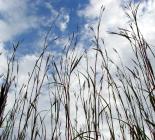1
Living Prairie, a poem by Len Carroll2002
Living Prairie Museum, St. James, Winnipeg, Manitoba, Canada

2
Living Prairie PoemBy: Len Carroll
The Living Prairie, as I remember it in my early years, some seventy years ago, was truly a fascinating entity.
A short ways away from where we lived on the farm was a plot (several acres in extent) of natural undisturbed prairie. In summer it was a mass of native grass of many species, brilliant with color from wild flowers. Most notable to me were the Tiger Lilies in such abundance that I'm sure my mother got tired of the almost daily bouquets in my pre-school days.
Beyond the end of our farm lay several miles of raw, undeveloped land, that as a youth was my private and personal "wilderness". Our cattle would stray so that, out there, and as a boy I could indulge my dream of being a cowboy.
This area was abundant in wild flowers of many kinds; morning glories, blue bells, daisies, daffodils, brown-eyed susans and my favourite of all, the pink lady slippers. My older brother would take bouquets of them to the R. R. station and sell them to the passengers on the trains.
The prairie is said to be so silent, so vacant of activity, so much of nothing, so barren and lonely.
They, who say that, have never heard-never taken the time to hear: A hot August afternoon, the incessant whine of the insects, the buzz of saw flies, the loud bleating of a million "crickets". No melody, just music. No one who ever heard the voice of the meadowlark or the Mourning Dove, ever forgot them. Even now I hear the crows-either singularly or at their conferences in loud raucous arguments; or the soft, silky swish of the night hawk's wings.
Where I live now, on the edge of the "Sandhills" there are different natural grasses in what has become "Provincial Park"-to use, still just the Sandhills, where we ran a lot of cattle before "park and recreation" time.
Here we have the hardy grasses of the ranch country. The most important to the Ranch People is (was) the "Blue Stem Gramma"; a short, sparse grass, native to all "High Plains" Country from here to Mexico. Its value is in the fact that it cures on the stem and is invaluable to Ranch people for winter grazing.
It has mostly disappeared from the range land now as a result of overgrazing and the lack of understanding of its value. I'm happy that I can still find a few patches of it; it was native from here to Mexico.
The prairie was dotted with shrubs, willows around the sloughs where the ducks and "mudhens" congregated in spring. There were bluffs of poplar and aspen where the white-tailed deer held forth. Wildlife was plentiful, coyotes galore. Snowy Owls in winter, Red-tailed hawks in summer, who came back to the same haunts every summer. Prairie chickens seemed to be everywhere.
The first real spring day was to see the Crocus poking up between the vanishing patches of snow; but I think the thing I awaited for most in the spring was the chorus of frogs croaking from the sloughs. An adage was that they had to be silenced three times before it was really spring.
Oh yeah! Crows, crows it seemed, by the millions. They were considered predators to the farming community. They loved to steal "baby chicks" and could be a real menace to a poultry-raising house wife. There was a municipal bounty on their legs and their eggs. As boys, we climbed many a tree for that purpose.
Seems strange now to have been "at war" with the most intelligent of the bird species.
PS: As a codicil, let me add:
The fruits and berries native to the prairie:
Saskatoons - we picked and canned hundreds of quarts
Chokecherries - for jams
Cranberries -for jams
Blueberries - for fruit
Gooseberries -for jams
Pincherries -for jams
Even Sand cherries and hazel nuts, all of these fruits were important and useful to the Prairie People of that era.